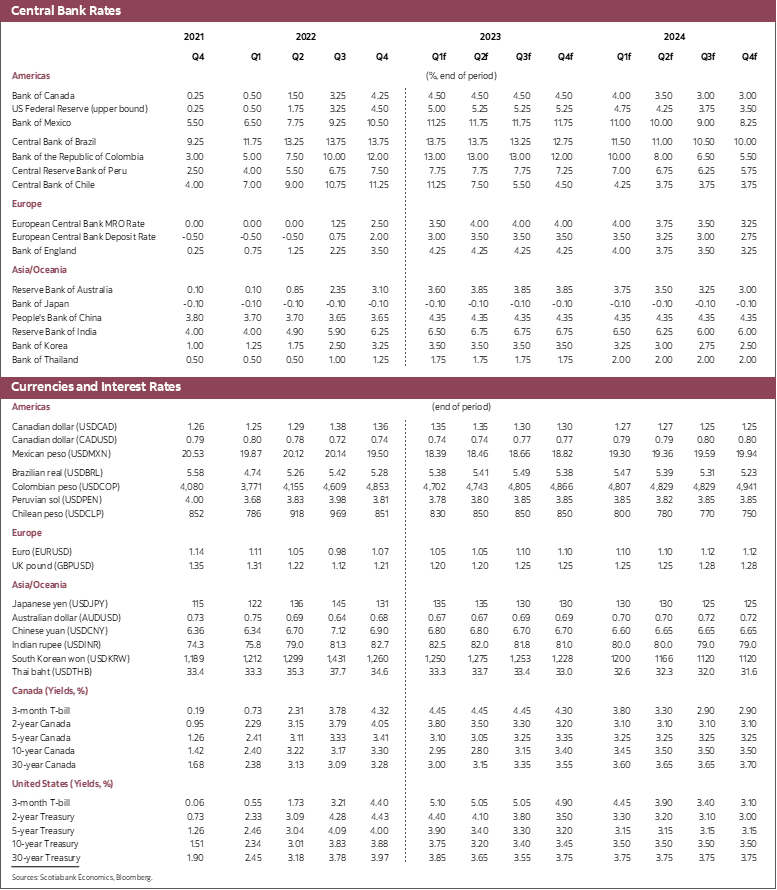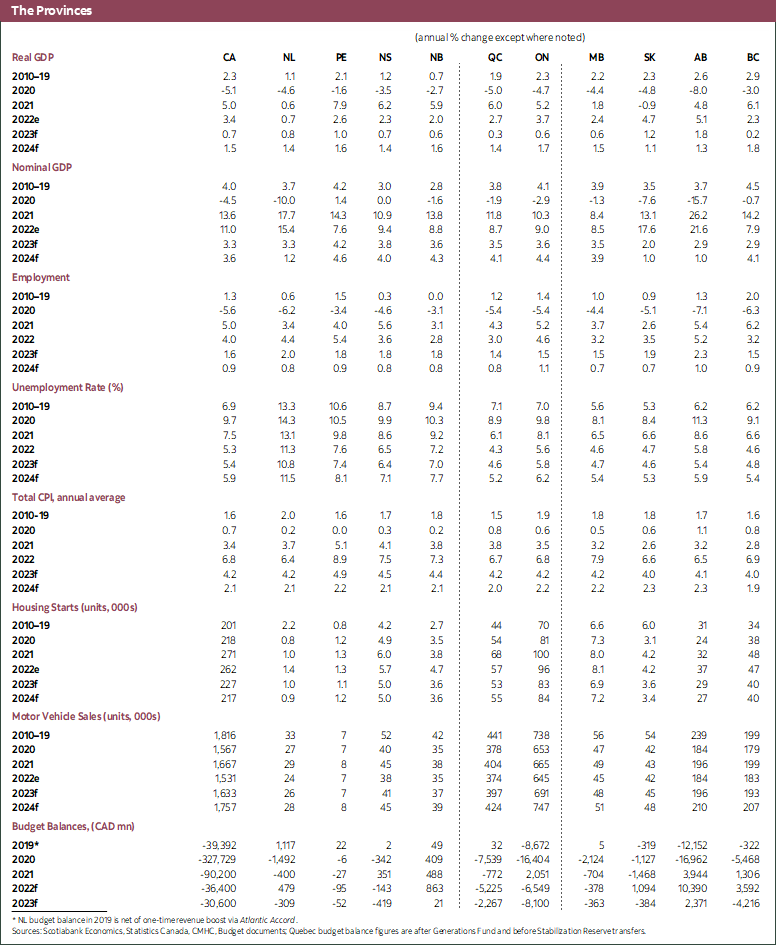- The failure of US banks is a concern and is adding significant uncertainty to the outlook. The market reaction to developments has been extreme and likely overblown. We do not think we are on the precipice of a broad financial crisis.
- These developments are almost certain to modestly weaken US and global economic growth and we have taken growth forecasts down accordingly. We remain of the view that a mild recession is the most likely outcome, but our conviction on this call is wavering.
- Inflation remains the dominant concern for the Federal Reserve and other central banks. We do not believe the challenges in the banking system will outweigh concerns about inflation control. We believe markets have dramatically over-reacted to recent developments and we continue to believe the Federal Reserve will raise rates by a combined 50 basis points at its next two meetings. We expect the US and Canadian central banks to cut rates in early 2024, in contrast to current pricing in markets.
The failures of Silicon Valley Bank and Signature Bank undoubtedly pose a material risk to the global outlook. Financial markets have responded dramatically, leading to a wild reassessment of the path of monetary policy in the US and Canada. In the US, for instance, markets went from pricing a nearly 6% terminal Federal Funds Rate later this year to a year-end rate of around 4% in the span of a few days. This of course reverberated through the yield curve, leading to a dramatic reduction in yields at all maturities. The risks of contagion are evident and there are reasons to be concerned, but the aggressive response by US policymakers that saw them guarantee all deposits in these banks and provide emergency liquidity assistance should quell risks of an additional deterioration. As Derek Holt noted, “It cannot be overstated how absolutely precedent setting” these actions are. As a result, we believe the dramatic re-pricing of rate expectations is very much overblown. We continue to expect additional rate increases of 25 bps by the Federal Reserve at its next two meetings, though we were admittedly leaning towards a 50bps move and a higher terminal value prior to the banks’ collapse.
The question at the heart of the rate calls is whether the impact of the failures will be of sufficient macroeconomic consequence to negate the impact of stronger than expected PCE inflation and a still robust jobs market in the US. We are shaving our US forecast to account for the uncertainty and demand impacts of these developments. The banking issue is almost certain to lead to reduced provision of credit. We now forecast US growth of around 1% this year and next and continue to believe a mild recession will begin in Q2. That recession is likely to be modestly deeper now than earlier forecast. Inflation is nevertheless forecast to be higher than in previous forecasts owing to readings thus far this year that cast doubt on the speed at which inflation will decline. The core personal consumption deflator accelerated sharply on a monthly basis in January, and February core CPI inflation accelerated as well. The stickiness in inflation seems to be related in part to the lagged impact of supplier delivery challenges as the inclusion of PMI supplier delivery times improves the performance of our US inflation forecasting methodology, as it does in our Canadian model.
Some argue that the failure of these banks is an indication that the Federal Reserve’s interest rate policy is leading to some unintended consequences that should prompt a reassessment of the stance of monetary policy. We disagree. In our view the challenges faced by these banks represents a fundamental failure of management in light of the evident direction that rates, and the yield curve have been on for more than a year now. The US continues to have an inflation problem that requires modest additional tightening. That concern should dominate other considerations, particularly given the scope of the measures laid out to contain the problems at the affected banks. The February US inflation print is a reminder that inflation continues to be a challenge in the US, and that the Federal Reserve’s job is not yet done. As a result, we continue to expect additional 25 basis points increases by the Fed at the next two meetings. We do not believe interest rates will be cut this year. Additional increases may be required beyond the 50bps we predict if inflation remains sticky at current levels, but as René Lalonde and Patrick Perrier estimate, the real policy rate should continue to increase throughout the year if inflation declines as generally expected.
In Canada, there is some evidence that the economy is slowing, but it remains mixed. Statistics Canada’s Real-Time Local Business Conditions Index shows a moderation of activity in early February though the job market continues to display remarkable strength in the first two months of the year. We remain of the view that Canada will experience a mild recession in Q2 and Q3, a view that is reinforced by the negative revision to US growth. In contrast to the US, some measures of core inflation in Canada point to a more noticeable cooling trend but we are raising our inflation forecast very modestly in Canada on account of stronger US inflation. This should still allow the Bank of Canada to keep its policy rate at 4.5% through the year, before gradually cutting rates through 2024. We expect the BoC policy rate will stand at 3% at end-2024. As noted, the real BoC policy rate will rise significantly as the year progresses despite our forecast of a flat nominal rate through the end of this year. The risks to this rate path are undoubtedly tilted to the upside in the next few months. If Canadian inflation begins to exhibit the same behaviour as US inflation since the beginning of the year, or if the economy does not slow as expected, Governor Macklem may need to raise rates further late Spring or early Summer. If that became a necessity, he would likely need to raise the policy by more than a simple 25bps move.




DISCLAIMER
This report has been prepared by Scotiabank Economics as a resource for the clients of Scotiabank. Opinions, estimates and projections contained herein are our own as of the date hereof and are subject to change without notice. The information and opinions contained herein have been compiled or arrived at from sources believed reliable but no representation or warranty, express or implied, is made as to their accuracy or completeness. Neither Scotiabank nor any of its officers, directors, partners, employees or affiliates accepts any liability whatsoever for any direct or consequential loss arising from any use of this report or its contents.
These reports are provided to you for informational purposes only. This report is not, and is not constructed as, an offer to sell or solicitation of any offer to buy any financial instrument, nor shall this report be construed as an opinion as to whether you should enter into any swap or trading strategy involving a swap or any other transaction. The information contained in this report is not intended to be, and does not constitute, a recommendation of a swap or trading strategy involving a swap within the meaning of U.S. Commodity Futures Trading Commission Regulation 23.434 and Appendix A thereto. This material is not intended to be individually tailored to your needs or characteristics and should not be viewed as a “call to action” or suggestion that you enter into a swap or trading strategy involving a swap or any other transaction. Scotiabank may engage in transactions in a manner inconsistent with the views discussed this report and may have positions, or be in the process of acquiring or disposing of positions, referred to in this report.
Scotiabank, its affiliates and any of their respective officers, directors and employees may from time to time take positions in currencies, act as managers, co-managers or underwriters of a public offering or act as principals or agents, deal in, own or act as market makers or advisors, brokers or commercial and/or investment bankers in relation to securities or related derivatives. As a result of these actions, Scotiabank may receive remuneration. All Scotiabank products and services are subject to the terms of applicable agreements and local regulations. Officers, directors and employees of Scotiabank and its affiliates may serve as directors of corporations.
Any securities discussed in this report may not be suitable for all investors. Scotiabank recommends that investors independently evaluate any issuer and security discussed in this report, and consult with any advisors they deem necessary prior to making any investment.
This report and all information, opinions and conclusions contained in it are protected by copyright. This information may not be reproduced without the prior express written consent of Scotiabank.
™ Trademark of The Bank of Nova Scotia. Used under license, where applicable.
Scotiabank, together with “Global Banking and Markets”, is a marketing name for the global corporate and investment banking and capital markets businesses of The Bank of Nova Scotia and certain of its affiliates in the countries where they operate, including; Scotiabank Europe plc; Scotiabank (Ireland) Designated Activity Company; Scotiabank Inverlat S.A., Institución de Banca Múltiple, Grupo Financiero Scotiabank Inverlat, Scotia Inverlat Casa de Bolsa, S.A. de C.V., Grupo Financiero Scotiabank Inverlat, Scotia Inverlat Derivados S.A. de C.V. – all members of the Scotiabank group and authorized users of the Scotiabank mark. The Bank of Nova Scotia is incorporated in Canada with limited liability and is authorised and regulated by the Office of the Superintendent of Financial Institutions Canada. The Bank of Nova Scotia is authorized by the UK Prudential Regulation Authority and is subject to regulation by the UK Financial Conduct Authority and limited regulation by the UK Prudential Regulation Authority. Details about the extent of The Bank of Nova Scotia's regulation by the UK Prudential Regulation Authority are available from us on request. Scotiabank Europe plc is authorized by the UK Prudential Regulation Authority and regulated by the UK Financial Conduct Authority and the UK Prudential Regulation Authority.
Scotiabank Inverlat, S.A., Scotia Inverlat Casa de Bolsa, S.A. de C.V, Grupo Financiero Scotiabank Inverlat, and Scotia Inverlat Derivados, S.A. de C.V., are each authorized and regulated by the Mexican financial authorities.
Not all products and services are offered in all jurisdictions. Services described are available in jurisdictions where permitted by law.

